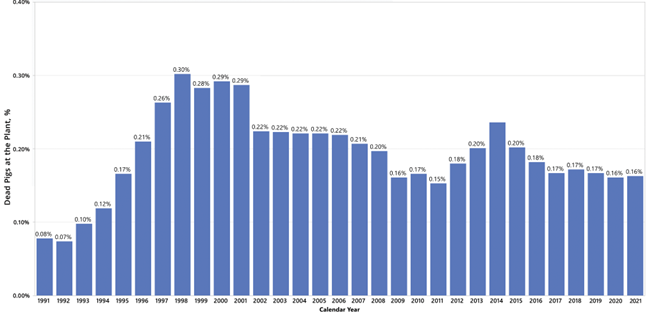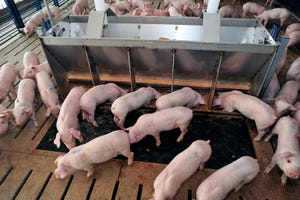Loading and transporting heavyweight hogs in summer heat
Consider loading practices, facility/trailer design, transport preparations, driving practices, weather conditions and if pigs fit for transport.
August 8, 2023

By Elanco Swine
When it comes to transportation, many factors should be considered to minimize stress and enhance pig welfare. These include weather conditions, trailer and facility maintenance, pig fitness for transport and handler/driver behavior. All these factors can have a pronounced negative effect on pig welfare and meat quality.
In particular, weather and the negative impacts of hot environmental conditions and the associated risks for negative welfare, should be considered this summer. Extreme ambient temperatures and humidity levels have a greater effect on heavy pigs due to their lack of sweat glands and thick subcutaneous fat. Furthermore, the average live weight of pigs has increased each decade, from an average live weight of 243 to 290 pounds from 1984 to 20221, respectively.
Research shows that the rate of dead on arrivals is higher in the summer, with increases in DOAs seen in temperatures ranging from 70 degrees to over 100 degrees Fahrenheit.2,3,4 Furthermore, the monthly incidence of dead pigs (DOA and dead in pen) from USDA-inspected plants is illustrated in Figure 1 for the calendar years 1991-2022.5* Recent published work indicates the percentage of dead pigs arriving at packing plants are highest during the months of July, August and September.4

Elanco. Figure 1. Percentage of dead market pigs at USDA-inspected plants for the calendar years 1991-2022.5*
When transporting pigs in the summer, key aspects that need to be considered include appropriate loading/unloading practices, proper facility/trailer design and maintenance, transport preparations and communication, good driving practices, proper setup for weather conditions and ensuring pigs are fit for transport. Proper management of all these areas ensure that producers, handlers and transporters contribute to positive pig welfare outcomes and improved meat quality.
The welfare risks associated with handling and transporting heavyweight pigs during hot weather conditions emphasizes the importance of minimizing stress on pigs throughout the marketing process, particularly during the summer. Here are considerations with some practical handling tips to help keep your pigs safe and healthy during the summer months.
Facilities should be properly designed, constructed and in good repair with functional equipment in place before loading or unloading pigs:
Lighting: Avoid areas that switch from light to dark, areas that have strong shadows or light shining into the eyes of the pig, all which can discourage movement.
Alleyways and doorways: Doorways should be at least the same width as the alleyway, and the door should open completely to eliminate pinch points. Avoid thresholds on the floor of the doorway to reduce balking.
Ramps and chutes: The loading chute should be designed to facilitate easy pig movement, reduce incidence of slips and falls and avoid injury and stress to the pig. Ramps should be 20 degrees or less.
Livestock trailers should be designed and maintained in a manner that is conducive to the humane transport of pigs:
Flooring: The trailer should have non-slip solid flooring.
Gates and Doors: All should open and close freely; they must be able to be secured shut and not have gaps.
Internal ramps: They should sit flush, with panels/rails in place to prevent animals from falling off the side. Ramps should not be so steep they cause animals to slip, and should be constructed of non-slip material.
Drain plugs: Ensure drain plugs are securely in place prior to loading pigs on the trailer.
Lighting: Trailer interior should be equipped with sufficient lighting if loading or unloading trailers in the dark.
Wetting pigs: Any shower/wetting mechanism used to cool pigs on board should be in good working order, especially in warm to hot temperatures.
Farms and plants should have sufficient unloading capacity so trucks can unload promptly:
Unloading ramps: Should have a leveled dock before the ramps go down so animals may walk on a level surface when they exit the truck. A good target for the ramp slope is no more than 20 degrees.
Stair steps: Recommended on concrete ramps because they provide better traction than cleats or grooves when ramps are dirty.
Flooring and ramp surfaces: Should be non-slip to avoid injury.
When preparing to ship market weight pigs, remember:
Routinely move pigs from their home pen to the loadout area during the grow-finish period.6
Presort market weight pigs prior to loading. Presorting is shown to decrease the percentage of dead and non-ambulatory pigs at the packing plant by 66% and lessen physical signs of stress during loading and unloading.7
Withdraw feed for 16-24 hours prior to loading.6
Prepare the facilities for loadout.8 Prepare the barn for movement by removing visual gaps between pens and distracting elements.
Loading crews and drivers should discuss the following information prior to loading:
Number of pigs to load, estimated weight of the pigs and barn cut.
Access a weather report prior to loading. Review the Livestock Hot Weather Safety Index (Figure 2) and your system's standard operating procedures for bedding and showering pigs. Drivers should adjust trailer settings to match the environmental conditions at the farm.
Schedule transportation early in the morning or at night.
The plant where pigs are being shipped.
Any special loading instruction (culls, split-load, etc.).

Elanco. Figure 2. The Livestock Hot Weather Safety Index*8
When loading/unloading animals, remember:
Adjust load size according to trailer length, pig weight and weather.
During the summer months, loading densities should not exceed 55-58 lbs/ft2.
Develop a “cheat sheet” for the number of pigs to be loaded into each compartment for common pig weights in your system (i.e. 250 lbs, 275 lbs, 300 lbs, 325 lbs, 350 lbs).
Transport losses increase with load weights under 46,000 lbs and over 48,000 lbs.
Follow the transport space recommendations (Figure 3) to adjust trailer loadings as pig weights change.
All pigs presented for transport must be fit for transport. Loading unfit or compromised pigs is unacceptable and considered an outright act of animal abuse.

Elanco. Figure 3. Transport space recommendations by the National Pork Board’s Transport Quality Assurance (TQA) Handbook*8
When transporting animals, drivers should remember to:
Ensure the safety of the public, animals and themselves while on the road.
Respond to transport situations professionally.
Uphold the welfare and humane treatment of the animals.
Protect company property (e.g., the animals, equipment).
Project a positive perception of the company and the industry.
Practice safe handling of animals and careful, responsible driving to prevent bruises, injuries and stress in pigs.
Adjust driving appropriately for road, weather and traffic conditions.
Avoid distractions such as eating, drinking, talking on the phone, reading, texting or reaching for items on the floor or across the seat.
References:
USDA. National Agricultural Statistics Service, Quick Stats. Available here. Accessed June 23, 2023.
Texas Tech University, Laboratory of Animal Behavior, Physiology and Welfare. Pig transport during warm weather. Available here. Accessed May 16, 2022.
Sutherland MA, McDonald A, McGlone JJ. Effects of variations in the environment, length of journey and type of trailer on the mortality and morbidity of pigs being transported to slaughter. Vet. Record. 165:13-18. (Abstr.). 2009.
Ritter MJ, Yoder CL, Jones CL, et al. Transport losses in market weight pigs: II. US incidence and economic impact. Trans. Anim. Sci. 4:1-10. 2022.
Elanco Animal Health. Data on File.
Ritter M, Ellis M, Johnson AK. Management Strategies to Reduce Transport losses in market weight pigs. Factsheet, Pork Information Gateway. PIG 05-06-07. Available here. Accessed May 16, 2022.
Johnson A, Sadler L, Gesing LM, et al. Effects of facility system design on the stress responses and market losses of market-weight pigs during loading and unloading. Prof. Anim. Sci. 26:9-17. 2010.
National Pork Board. Transport Quality Assurance (TQA) Handbook version 7. Accessed May
You May Also Like



